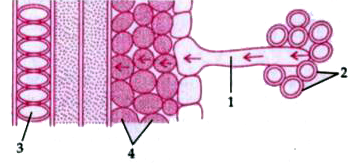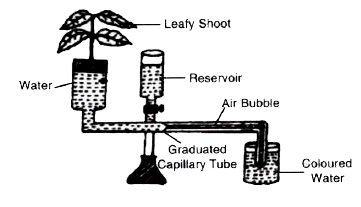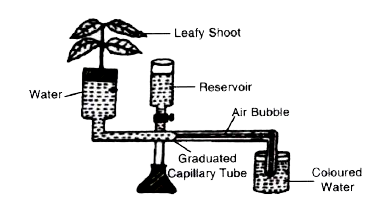Complete Solutions to SECTION-II of chapter SAMPLE PAPER 2016 of Class 10 book with complete answers and questions
| Class 10 | BIOLOGY |
| Chapter | SAMPLE PAPER 2016 |
| GURUKUL | SECTION-II |
| Number Of Questions | 62 |
| Academic Year | 2023-24 |
The figure given below is a diagrammatic representation of a part of the cross section of the root in the root hair zone. Study the same and then answer the questions that follow :

Name the parts indicated by the guidelines 1 to 4.
View SolutionThe figure given below is a diagrammatic representation of a part of the cross section of the root in the root hair zone. Study the same and then answer the questions that follow :

Which is the process that enables the passage of water from the soil into the root hair?
View SolutionThe figure given below is a diagrammatic representation of a part of the cross-section of the root in the root hair zone. Study the same and then answer the questions that follow :

What pressure is responsible for the movement of water in the direction indicated by arrows ?
View SolutionThe figure given below is a diagrammatic representation of a part of the cross section of the root in the root hair zone. Study the same and then answer the questions that follow :

Due to an excess of this pressure sometimes drops of water are found along the leaf margins of some plants especially in the early mornings. What is the phenomenon called ?
View SolutionThe figure given below is a diagrammatic representation of a part of the cross-section of the root in the root hair zone. Study the same and then answer the questions that follow :

Draw a labelled diagram of the root hair cell as it would appear if some fertilizer is added to the soil close to it.
View SolutionDifferentiate as directed :
Human skin cell and Human ovum (Number of chromosomes).
View SolutionDifferentiate between :
Sperm duct and fallopian tube (Function).
View SolutionDifferentiate between the following pairs on the basis of what is mentioned within brackets :
Red Cross and WHO (one activity).
View SolutionGive one difference between the following pairs on the basis of what is given in brackets :
Rods and Cones (Pigment present)
View SolutionTabulate differences between:
LUB and DUB (Names of valves whose closure produce sound
View SolutionGiven below is the outline of the human body showing the important glands:

Name the glands marked 1 to 4
View SolutionGiven below is the outline of the human body showing the important glands:

Name the hormone secreted by part B. Give one important function of this hormone.
View SolutionGiven below is the outline of the human body showing the important glands:

Name the endocrine part of the numbered C.
View SolutionGiven below is the outline of the human body showing the important glands:

Why is the part labelled A called the master gland? Which part of the forebrain controls the gland labelled A?
View SolutionGiven below is the outline of the human body showing the important glands:

Name the gland that secretes the 'emergency hormone.
View SolutionThe diagram of an apparatus given below demonstrates a particular process in plants. Study the same and answer the questions that follow :

Name the apparatus.
View SolutionThe diagram of an apparatus given below demonstrates a particular process in plants. Study the same and answer the questions that follow :

Which phenomenon is demonstrated by this apparatus?
View SolutionThe diagram of an apparatus given below demonstrates a particular process in plants. Study the same and answer the questions that follow :

Explain the phenomenon mentioned in demonstrated
View SolutionThe diagram of an apparatus given below demonstrates a particular process in plants. Study the same and answer the questions that follow :

State two limitations of using this apparatus.
View SolutionThe diagram of an apparatus given below demonstrates a particular process in plants. Study the same and answer the questions that follow :

What is the importance of the air bubble in the experiment ?
View SolutionThe diagram of an apparatus given below demonstrates a particular process in plants. Study the same and answer the questions that follow :

Name the structures in a plant through which the above process takes place.
View SolutionDraw a well labelled diagram of the membranous labyrinth found in the inner ear.
View SolutionBased on the diagram drawn above in membranous labyrinth give a suitable term for each of the following descriptions: (1) The sensory cells that helps in hearing. (2) The part that is responsible for static balance of the body. (3) The membrane covered opening that connects the middle ear to the inner ear. (4) The fluid present in the middle chamber of cochlea. (5) The structure that maintains dynamic equilibrium of the body.
View SolutionGive technical terms for the following:
The permanent stoppage of the menstrual cycle in a woman aged 50 years.
View SolutionName the pigment providing colour to urine.
View SolutionName the following:
The vein which drains the blood from the intestine to the liver
View SolutionName the following :
The canal through which the testes descend into scrotum just before birth
View SolutionGive the biological/technical term for the following:
The process causing an undesirable change in the environment.
View SolutionName the The process of removal of nitrogenous wastes from the body.
View SolutionThe repeating components of each DNA strand lengthwise.
View SolutionGive biological/ technical terms for the following:
An alternation in the genetic material that can be inherited.
View SolutionGive technical term for:
The process of uptake of mineral ions against the concentration gradient using energy from cell.
View SolutionName the following:
Blood vessels carrying blood to the left atrium
View SolutionThe given diagram shows a stage during mitotic division in an animal cell:

Identify the stage. Give a reason to support your answer.
View SolutionThe given diagram shows a stage during mitotic division in an animal cell:

Draw a neat labelled diagram of the cell as it would appear in the next stage. Name the stage.
View SolutionThe given diagram shows a stage during mitotic division in an animal cell:

In what two ways is mitotic division in an animal cell different from the mitotic division in a plant cell?
View SolutionThe given diagram shows a stage during mitotic division in an animal cell:

Name the type of cell division that occurs during:
A. Growth of a shoot
B. Formation of pollen grains.
View Solution(i) Why is colour blindness more prominent in males than females?
(ii) Why is Drosophila used extensively for genetic studies?
View SolutionGive biological reasons for the following :
Injury to Medulla oblongata results in death.
View SolutionGive technical terms for the following:
The permanent stoppage of the menstrual cycle in a woman aged 50 years.
View SolutionGive scientific reasons for the following statements:
Loss of nucleus and mitochondria make erythrocytes more efficient in their function.
View SolutionExplain briefly :
Blood flows in arteries in spurts and is under pressure
View SolutionThe diagram given below is that of a developing human foetus. Study the diagram and then answer the questions that follow :

(i) Label the parts numbered 1 to 3 in the diagram.
(ii) Mention any two functions of the part labelled 2 in the diagram.
(iii) Explain the significance of the part numbered 3 in the diagram.
(iv) Define the term 'Gestation'. What is the normal gestational period of the developing human embryo?
(v) Mention the sex chromosomes in a male and female embryo.
View SolutionThe diagram given below is that of a developing human foetus. Study the diagram and then answer the questions that follow :

(i) Label the parts numbered 1 to 3 in the diagram.
(ii) Mention any two functions of the part labelled 2 in the diagram.
(iii) Explain the significance of the part numbered 3 in the diagram.
(iv) Define the term 'Gestation'. What is the normal gestational period of the developing human embryo?
(v) Mention the sex chromosomes in a male and female embryo.
View SolutionThe diagram given below is that of a developing human foetus. Study the diagram and then answer the questions that follow :

(i) Label the parts numbered 1 to 3 in the diagram.
(ii) Mention any two functions of the part labelled 2 in the diagram.
(iii) Explain the significance of the part numbered 3 in the diagram.
(iv) Define the term 'Gestation'. What is the normal gestational period of the developing human embryo?
(v) Mention the sex chromosomes in a male and female embryo.
View SolutionThe diagram given below is that of a developing human foetus. Study the diagram and then answer the questions that follow :

Define the term 'Gestation'. What is the normal gestational period of the developing human embryo ?
View SolutionThe diagram given below is that of a developing human foetus. Study the diagram and then answer the questions that follow :

Mention the sex chromosomes in a male and female embryo.
View SolutionThe following diagram demonstrates a physiological process taking place in green plants. The whole set up was placed in bright sunlight for several hours. Study the diagram and answer the questions that follow :

What aspect of the physiological process is being examined ?
View SolutionThe following diagram demonstrates a physiological process taking place in green plants. The whole set up was placed in bright sunlight for several hours. Study the diagram and answer the questions that follow :

Explain the physiological process
View SolutionThe following diagram demonstrates a physiological process taking place in green plants. The whole set up was placed in bright sunlight for several hours. Study the diagram and answer the questions that follow :

Label the parts numbered 1 and 2 in the diagram.
View SolutionThe following diagram demonstrates a physiological process taking place in green plants. The whole set up was placed in bright sunlight for several hours. Study the diagram and answer the questions that follow :

Write a well-balanced chemical equation for the physiological process
View SolutionThe following diagram demonstrates a physiological process taking place in green plants. The whole set up was placed in bright sunlight for several hours. Study the diagram and answer the questions that follow:

What would happen to the rate of bubbling of the gas if a pinch of sodium bicarbonate is added to the water in the beaker? Explain your answer
View SolutionA homozygous tall plant (T) bearing red coloured ( R ) flowers is crossed with a homozygous dwarf (t) plant bearing white (r) flowers :
Give the genotype and phenotype of the plants of `F_1` generation.
View SolutionA homozygous tall plant (T) bearing red coloured ( R ) flowers is crossed with a homozygous dwarf (t) plant bearing white (r) flowers :
Mention the possible combinations of the gametes that can be obtained from the F1 hybrid plant.
View SolutionA homozygous tall plant (T) bearing red coloured ( R ) flowers is crossed with a homozygous dwarf (t) plant bearing white (r) flowers :
State the Mendel's law of Independent Assortment.
View SolutionA homozygous tall plant (T) bearing red coloured ( R ) flowers is crossed with a homozygous dwarf (t) plant bearing white (r) flowers :
Mention the phenotypes of the offspring obtained in `F_2` generation.
View SolutionA homozygous tall plant (T) bearing red coloured ( R ) flowers is crossed with a homozygous dwarf (t) plant bearing white (r) flowers :
What is the phenotypic ratio obtained in `F_2` generation ?
View SolutionExplain the term Reflex action.
View SolutionWith reference to the functioning of the eye, answer the questions that follow :
What is meant by power of accommodation of the eye?
View SolutionBriefly explain the following:
Photophosphorylation
View SolutionBriefly explain the Hormones
View SolutionAn electrical synapse differs from a chemical synapse in that the electrical synapse :
View Solution
SECTION-II questions and complete solutions for chapter SAMPLE PAPER 2016 of EVERGREEN BIOLOGY (ENGLISH) of Class 10